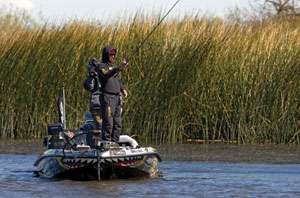
Life was simpler when monofilament was the only line choice. Then along came superbraid, followed by fluorocarbon. Each of these lines has unique properties, and advanced anglers use them for different applications.
Pure Fishing has complicated the decision by introducing Spiderwire Ultracast FluoroBraid, which incorporates Gore's expanded Polytetrafluoroethylene performance fibers. Unlike typical 100% Dyneema and Spectra braided lines, which float, Spiderwire Ultracast FluoroBraid sinks. Conventional floating braids excel for fishing topwater frogs and toads.
They're also widely used for punching through matted grass and Carolina rigging. With these subsurface presentations, heavy weights quickly pull a floating braid down and eliminate excessive bowing.
Because Ultracast FluoroBraid sinks, it is superior for penetrating grass and Carolina rigging. And, it opens the door to fishing lighter subsurface offerings, including jigs, Texas rigged plastics, sinking worms and finesse baits. The advantage with a sinking line is that it maintains a more direct contact with your lure.
This improves sensitivity, lure control and your hook set. This is one reason fluorocarbon line, which sinks, has become so popular. The name FluoroBraid is a play on fluorocarbon's sinking ability. However, there is no fluorocarbon in FluoroBraid. It is a 50/50 mix of Dyneema and Gore fibers. FluoroBraid is offered in line tests of 10, 15, 20, 30, 40, 50, 65, 80 and 100 pounds.
Bassmaster Elite Series pro Michael Iaconelli experimented with FluoroBraid before it was introduced to the public recently. "This is the biggest line innovation in years," Iaconelli said. "It will change the way we fish." Iaconelli still opts for a floating braid with frogs and toads, but he goes with FluoroBraid with sinking lures. When he fishes thick grass and slop with Texas rigged baits, Iaconelli claims that there is a "night and day difference" between a floating braid and FluoroBraid.
This was most noticeable when Iaconelli pitched a 3/8-ounce bait to holes in the grass. But, it held true even when he punched through the greenery with a 1-ounce sinker. "The bait sinks more naturally with FluoroBraid," Iaconelli said. "And, the line is so slick it casts great and gets in and out of the grass a lot smoother." Iaconelli said he loves braided line on spinning tackle because it eliminates line twist problems.
However, he doesn't like the way a floating braid hinders the sink rate of soft stickbaits and other unweighted plastic lures. "With FluoroBraid, weightless plastic baits have a faster, more natural sink rate," Iaconelli said. "That makes a huge difference." In tannic or stained water, Iaconelli ties FluoroBraid directly to the hook. In clear water, he attaches a 12- to 16-inch fluorocarbon leader to the braid with a nail knot or a tiny swivel.
He believes a swivel makes his bait look to a bass like a little fish chasing a smaller fish. FluoroBraid was in R&D for more than two years before it was deemed ready for the fishing world, according to Clay Norris, senior product manager for Spiderwire. "The diameter of FluoroBraid is about the same as Spiderwire Stealth Braid," Norris said. "It also has the same strength and low stretch of Stealth, and it has excellent abrasion resistance."
These are all worthy attributes, but Norris stresses that the biggest benefit of FluoroBraid is its ability to sink like fluorocarbon.





